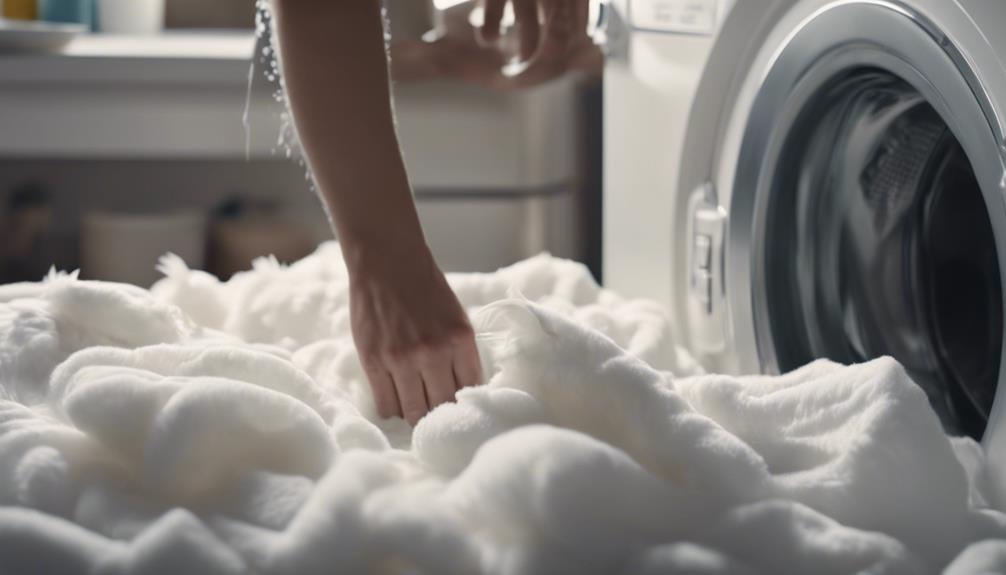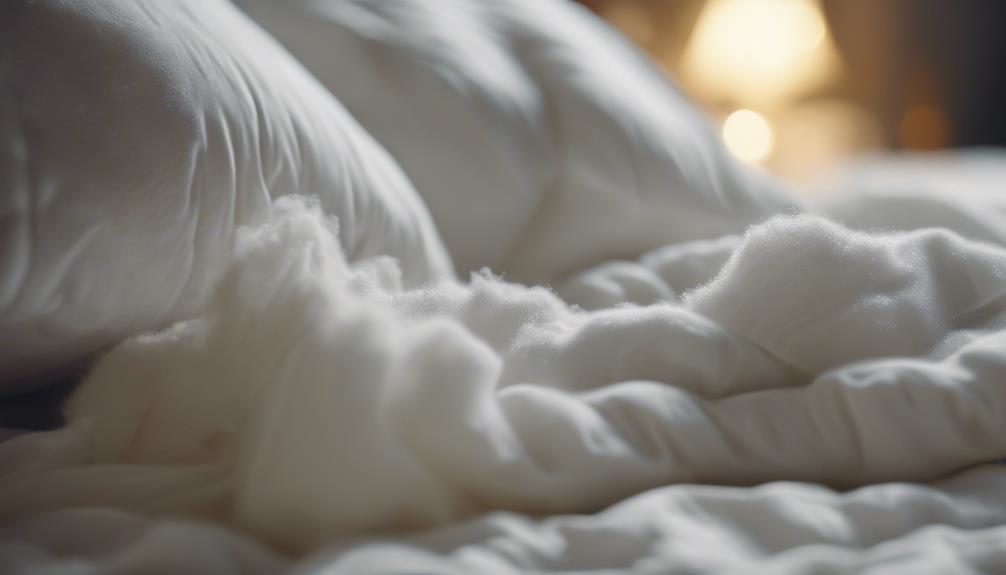If your comforter feels stiff after washing, it may be because of improper drying methods. To keep it soft, avoid high heat settings, opt for gentle cycles, and don’t overload the dryer. Clumped filling can also cause stiffness. Try using tennis or dryer balls to break up the clumps. Following care label instructions is crucial; use the correct detergent and air dry or use low heat. Ensuring proper airflow during drying is important. For more tips on maintaining your comforter’s softness and preventing stiffness, explore further guidance on drying techniques and fluffiness maintenance.
Key Takeaways
- Use low heat settings to prevent stiffness and fabric damage.
- Avoid overloading the dryer for proper air circulation.
- Regularly fluff and redistribute filling to maintain softness.
- Opt for gentle heat settings and proper drying techniques.
- Follow care label instructions for specific fabric care guidance.
Incorrect Drying Techniques

When drying your comforter, we must avoid high heat settings in the dryer to prevent stiffness and maintain its softness. Excessive heat can damage the fabric and strip it of its natural softness. It's important to select a gentle heat setting to make sure that the comforter dries evenly and remains fluffy.
Furthermore, overloading the dryer can hinder proper air circulation, leading to a stiff comforter. To prevent this, make sure the comforter has enough space to move around freely in the dryer. Additionally, using fabric softeners sparingly is advisable, as an excess of these products can leave a residue on the comforter, causing stiffness.
After washing your comforter in the washing machine, be mindful of the drying process. Opt for a low heat setting and consider using dryer balls to help fluff the comforter as it dries. By following these tips and avoiding common mistakes, you can maintain the softness and quality of your comforter for longer periods.
Clumped Filling

When clumped filling occurs in a comforter, the inner materials stick together, causing stiffness and discomfort.
To address this issue, it's essential to focus on proper filling distribution and drying techniques.
Filling Distribution
During the washing and drying process, clumped filling in a comforter can result from the bunching up of the filling material, causing stiffness and discomfort. Uneven distribution of the filling can lead to areas with excess filling and other spots with little to no filling, affecting the overall comfort and warmth of the comforter.
To prevent clumped filling, add a couple of tennis balls or dryer balls to the dryer to help break up the clumps. You can also shake the comforter periodically during the drying cycle. For maintenance, consider adding a small amount of baking soda to the comforter when washing to help loosen any clumps that may have formed over time. Regularly fluffing and redistributing the filling can also help maintain the softness and comfort of the comforter.
Proper Drying Techniques
To prevent clumped filling in your comforter and maintain its softness, using proper drying techniques is essential. Improper drying methods, like high heat settings, can cause the filling to clump together, resulting in a stiff comforter.
To avoid this, consider using dryer balls or clean tennis balls during the drying cycle to help fluff up the filling and prevent clumping, ultimately leading to a softer feel. Opting for air drying or using a low heat setting in the dryer can also help preserve the loftiness of the filling and prevent stiffness.
Remember to gently shake out the comforter during drying to evenly redistribute the filling and prevent it from clumping.
Additionally, avoid overloading the dryer with too many items, as this can compress the filling and make the comforter feel stiff after washing.
Care Label Instructions

By adhering to the care label instructions provided on your comforter, you can guarantee proper washing and drying techniques to maintain its softness and prevent stiffness. Different fabrics and fillings may have specific care requirements to make sure they stay soft after washing.
It's essential to select the right detergent and avoid washing in high heat, as these can contribute to stiffness. Air drying or using a low heat setting in the dryer can help preserve the comforter's softness.
Overloading the washer or dryer should be avoided to ensure thorough cleaning and prevent stiffness from setting in. Care labels offer valuable guidance on how to care for your comforter properly, so be sure to read and follow them diligently.
Proper Dryer Settings

When drying your comforter, remember to select a low heat setting to maintain its softness. High heat can damage the fibers, causing stiffness.
Opting for a gentle cycle and using dryer balls can also help prevent stiffness.
Heat Level Selection
Using the appropriate heat level setting on your dryer can help prevent your comforter from becoming stiff after washing. To maintain the softness of your comforter, it's recommended to use a low heat setting.
High heat settings can damage the fibers, causing the fabric to lose its original texture and comfort. Be cautious not to over-dry your comforter, as excessive heat can lead to stiffness and reduce its overall softness.
Timed Drying Options
To prevent stiffness in your comforter, consider setting the dryer to a low heat or air fluff option. Timed drying options allow you to control the drying duration, reducing the risk of the comforter becoming stiff.
Avoid over-drying, as this can strip the comforter of its softness. Additionally, using dryer balls or clean tennis balls in the dryer can help fluff up the comforter during the drying process, maintaining its plushness.
Always refer to the care label on the comforter for specific drying instructions to prevent stiffness. By following these tips and utilizing timed drying options, you can keep your comforter soft and cozy after each wash.
Use of Tennis Balls

In our quest to maintain the softness and fluffiness of our comforters, incorporating tennis balls into the drying process proves to be a practical and effective solution. Here are some reasons why using tennis balls can help improve the outcome of washing your comforter:
- Fluffing and Redistribution: Tennis balls can help fluff and redistribute the filling in a comforter during the drying process, preventing clumping and maintaining a lofty feel.
- Prevention of Clumping: The bouncing motion of tennis balls in the dryer can prevent clumping and stiffness in the comforter, ensuring an even dry and fluffy result.
- Cost-Effective Solution: Using tennis balls is a cost-effective and easy way to maintain the softness and loft of a comforter without the need for expensive dryer balls or other products.
- Cleanliness Consideration: Make sure to use clean tennis balls to avoid transferring dirt or residue onto the bedding, ensuring a hygienic drying process for your comforter.
Avoid Overloading Dryer

When drying your comforter, make sure the dryer isn't overloaded to prevent stiffness caused by uneven drying. Overloading the dryer can lead to issues such as clumping and stiffness in the comforter because proper air circulation is hindered.
To prevent stiffness, it's important to allow enough space in the dryer for the comforter to move freely during the drying cycle. By reducing the load in the dryer and avoiding overcrowding, you can help maintain the fluffiness and softness of your comforter after washing.
Properly spacing out items in the dryer is essential to ensure even drying and to prevent stiffness from setting in. Remember, a well-aired comforter is a comfortable comforter, so give it the space it needs in the dryer to avoid stiffness and maintain its cozy feel.
Proper Airflow Importance

Proper airflow during the drying process is essential for maintaining the softness of your comforter. Without adequate airflow, moisture can become trapped, leading to stiffness in the fabric.
To prevent this, make sure your comforter has access to good ventilation either by hanging it outside or using a dryer with proper airflow mechanisms.
Airflow and Drying
Ensuring sufficient airflow during the drying process is essential to prevent a comforter from stiffening after washing. Here are four key points to take into account:
- Promotes Even Drying: Adequate airflow helps the comforter dry evenly, preventing certain areas from becoming stiff while others remain damp.
- Prevents Dampness: Insufficient airflow can lead to pockets of dampness in the comforter, which contribute to stiffness as it dries.
- Retains Softness: Hanging the comforter outside or using a well-ventilated dryer promotes airflow, helping the comforter maintain its soft and fluffy texture.
- Avoids Moisture Trapping: Lack of airflow can trap moisture within the comforter fibers, resulting in stiffness and discomfort.
Preventing Moisture Buildup
To maintain a soft and comfortable feel in your comforter after washing, it is essential to prevent moisture buildup by ensuring proper airflow during the drying process. Proper airflow helps to dry the comforter thoroughly, preventing dampness that can lead to stiffness and discomfort. Lack of ventilation can trap moisture in the fibers, causing the comforter to feel stiff. To promote airflow, consider hanging the comforter outside on a clothesline or using a drying rack. Additionally, storing the comforter in a well-ventilated area post-wash can also help maintain its softness. Adequate ventilation in the laundry space is vital for preventing stiffness and ensuring your comforter stays cozy and inviting.
| Importance of Proper Airflow |
|---|
| Prevents Moisture Buildup |
| Promotes Thorough Drying |
| Maintains Softness |
Fluffiness Maintenance Tips

For fluffiness maintenance, tossing a couple of tennis balls or wool dryer balls in with your comforter during drying can help restore its softness and prevent stiffness.
Here are some additional tips to maintain the fluffiness of your comforter:
- Use Low Heat Setting: Opt for a low heat setting when drying your comforter with dryer balls to prevent overheating and potential damage to the fabric fibers.
- Shake Before Drying: Before placing the comforter in the dryer, shake it out to guarantee even distribution and prevent clumping, which can lead to stiffness.
- Avoid Overloading: To allow the comforter to move freely and regain its fluffiness, avoid overloading the dryer with too many items that may restrict movement.
- Regular Fluffing: Periodically remove the comforter from the dryer and fluff it by hand to maintain its loftiness and prevent it from becoming flat or stiff over time.
Tennis Balls Vs. Dryer Balls

When comparing tennis balls to dryer balls for maintaining the fluffiness of your comforter, consider the differences in noise levels and fabric gentleness.
Tennis balls are commonly used to help fluff and redistribute the filling in a comforter during the drying process. While they can be effective, they tend to create loud noises in the dryer due to their hard texture.
On the other hand, dryer balls, which are typically made of wool or plastic, work similarly to tennis balls but are designed to be gentler on fabrics. They not only reduce drying time and static but also offer a quieter laundry experience.
Dryer balls are known for being more gentle on delicate fabrics compared to the potential roughness of tennis balls. Both options can help maintain the loftiness of your comforter, but dryer balls may provide additional benefits such as a softer touch and reduced noise during the drying cycle.
Ensuring Even Drying

After discussing the benefits of using dryer balls or tennis balls for maintaining the fluffiness of your comforter, the focus now shifts to guaranteeing even drying to prevent stiffness.
To achieve best results and keep your comforter soft and cozy, follow these steps:
- Make sure to dry the comforter thoroughly to prevent stiffness. This will help eliminate any residual moisture that could lead to a stiff texture.
- Ensure the comforter is evenly distributed in the dryer for consistent drying. This will help all areas of the comforter dry evenly and prevent certain spots from becoming stiff.
- Use dryer balls or clean tennis balls to fluff the comforter during drying. These items can help maintain the fluffiness and prevent clumping, resulting in a softer comforter.
- Avoid overloading the dryer to allow proper airflow for even drying. Overloading the dryer can lead to uneven drying and potential stiffness. Shake out the comforter periodically during the drying process to prevent clumping and stiffness.
Frequently Asked Questions
How to Soften a Stiff Comforter?
To soften a stiff comforter, try adding white vinegar to the rinse cycle to break down residue. Use a tennis ball or dryer ball in the dryer to fluff it up.
Air dry outside on a sunny day to naturally soften the fabric. Toss a clean, damp washcloth in the dryer with the comforter for added moisture.
Consider using bedding-specific fabric softener for extra softness and a fresh scent.
How Do I Make My Comforter Soft Again?
To make your comforter soft again, try using fabric softener in the wash. It restores softness and helps prevent stiffness.
Use dryer balls or clean tennis balls when drying to fluff up the comforter. Air-drying also maintains softness.
Adding dryer sheets can further soften it. For even better results, toss the comforter with a damp towel in the dryer to loosen the fibers.
These methods will guarantee your comforter stays cozy and soft.
Why Did the Stuffing in My Comforter Get Hard?
When the stuffing in a comforter becomes hard after washing, it's often due to insufficient drying time, causing clumping and hardening of the filling.
Overloading the dryer or using high heat settings can lead to uneven drying and stiffness.
If there's not enough air circulation during drying, moisture can get trapped in the filling, resulting in hardness.
Avoid using harsh detergents or fabric softeners that can leave residues contributing to stiffness.
How to Fix a Crunchy Comforter?
When dealing with a crunchy comforter, consider adding tennis balls or dryer balls in the dryer to fluff and redistribute the filling evenly. Opt for a lower heat setting to maintain softness, and toss in a few clean, dry towels to help absorb excess moisture. Shake out the comforter during drying to prevent clumping.
Avoid overloading the dryer to allow free movement. These steps can help restore your comforter's plushness and prevent stiffness.
What Causes Comforters to Become Stiff and Crunchy After Washing?
After washing, a crunchy comforter can result from detergent residue. To fix this issue, consider using less detergent and adding vinegar to the rinse cycle. Additionally, using wool dryer balls or tennis balls can help fluff up the comforter during drying. Following these steps can lead to a softer outcome.
Conclusion
To sum up, ensuring your comforter maintains its softness after washing requires proper care and attention to detail.
By following the correct drying techniques, using tennis balls, and ensuring even airflow, you can keep your comforter fluffy and cozy.
Remember, taking care of your comforter is like tending to a delicate garden – with the right tools and techniques, you can enjoy its warmth and comfort for years to come.










